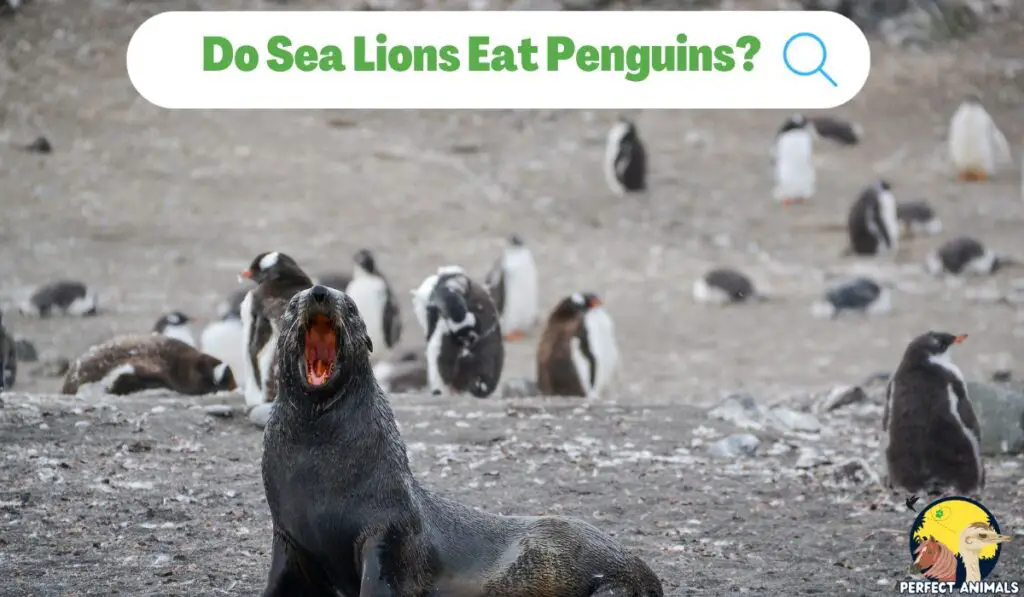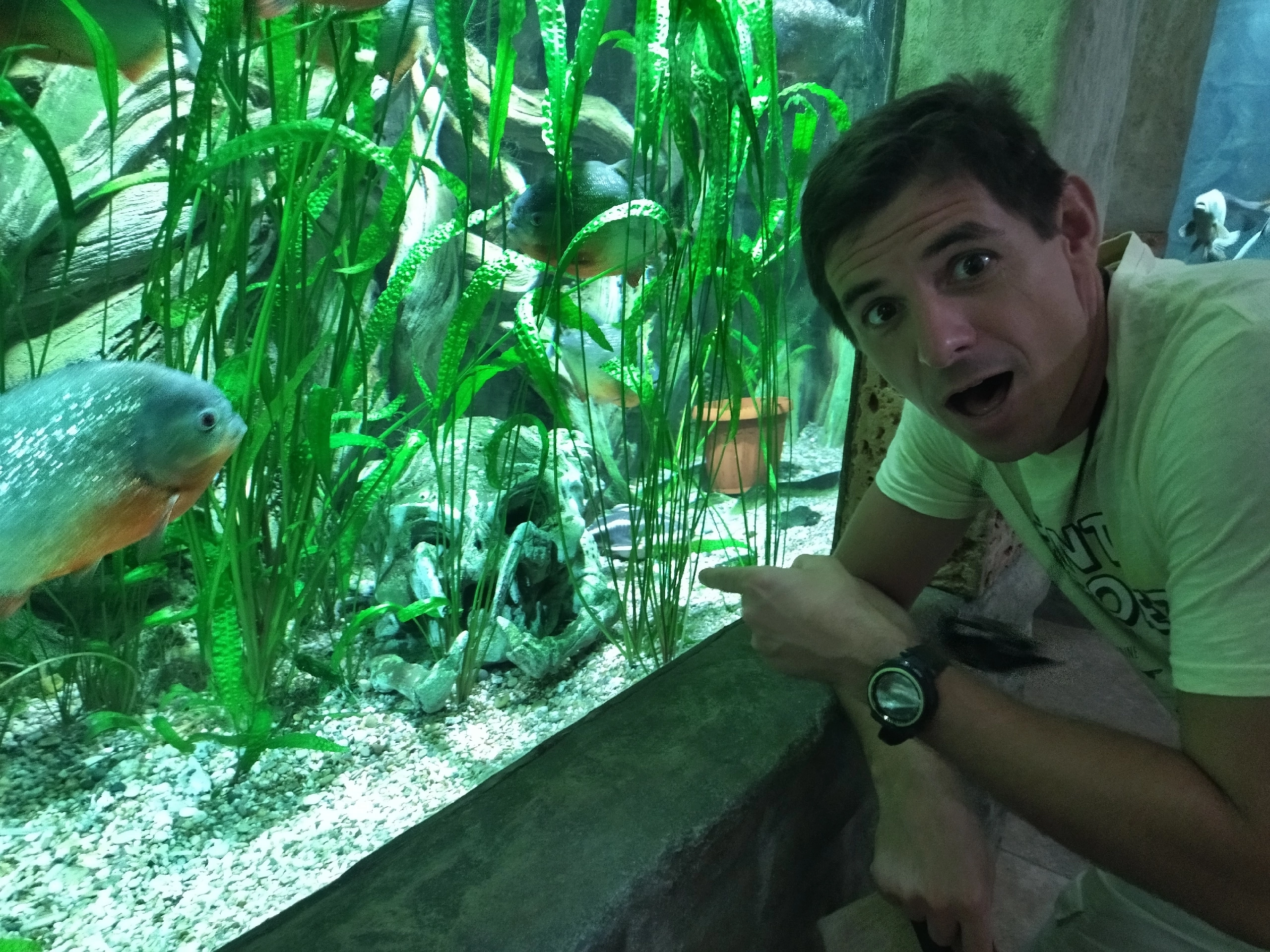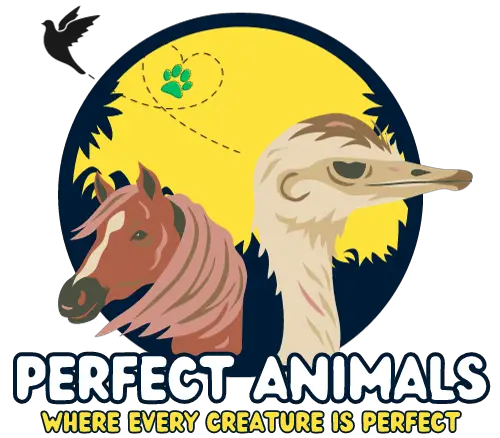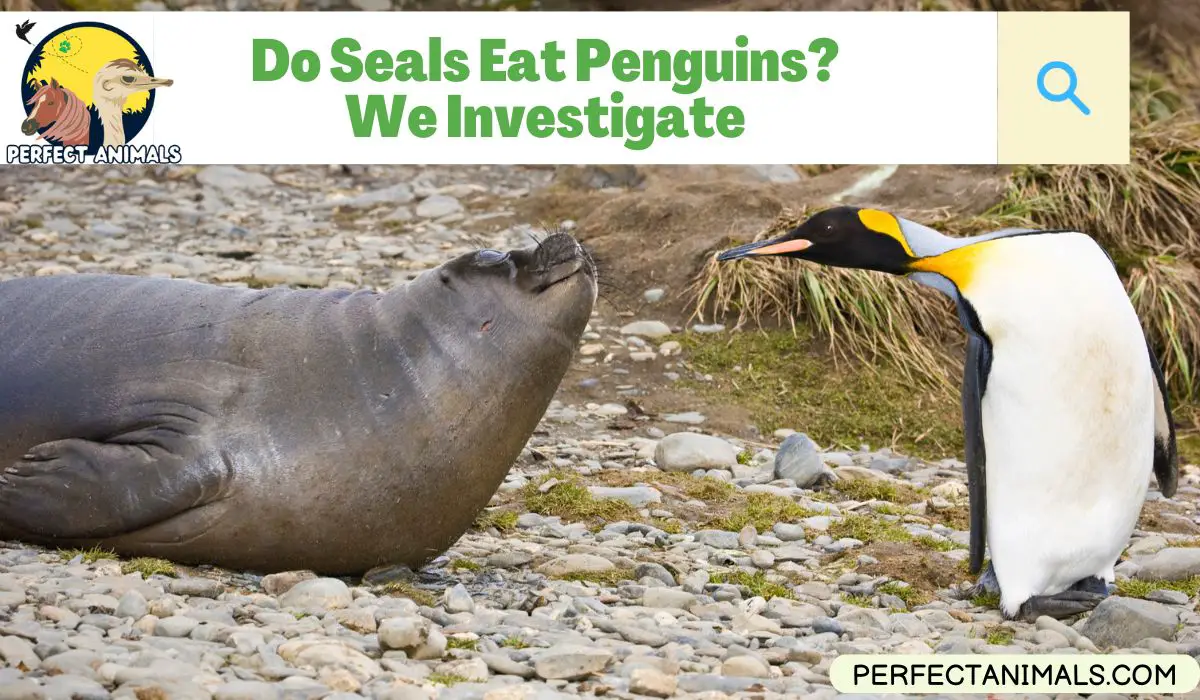Seals and penguins are two of the most iconic marine animals out there. They share overlapping habitats across the Southern Ocean and Antarctic regions.
However, while we often think of cute and cuddly interactions between species, the relationship between seals and penguins has an element of predator and prey. This leaves many to wonder: do seals eat penguins?
The answer isn’t so straightforward. There are over 30 different species of seals, from leopard seals to crabeater seals, inhabiting a range of environments.
With so many variations, some seals actively hunt penguins, especially the young and vulnerable. Yet others stick to a diet mainly comprised of fish, krill, and squid.
In this article, we’ll break down the details around seals and penguins. Looking at key seal species, we’ll analyze how their feeding patterns impact penguin populations.
We’ll also explore how penguins use their speed and agility to evade hungry seals. Whether you’re a seal or penguin fan, hopefully, you’ll leave with a better understanding of how these two marine animals interact.
Do Seals Eat Penguins?
The simple answer is yes, seals do eat penguins. Several seal species will prey on penguins when given the opportunity.
While seals largely feed on fish, squid, krill, and other marine life, they are opportunistic hunters. Penguins that venture too close to sealing colonies or resting areas may be targeted as an available food source.
Leopard seals, in particular, are powerful predators that pose a significant threat to penguin populations. Their speed, size, and formidable jaws make them effective hunters of penguins along with other seals and seabirds.
However, seals do not actively hunt penguins as their main food staple. Penguin colonies that are isolated from seal traffic tend to have higher breeding success and lower adult mortality rates.
Still, seals contribute to regulating penguin numbers in shared ecosystems.
Do Seals Eat Baby Penguins?
Seals are known to prey on baby penguins. Penguin chicks and juveniles are vulnerable targets for seals, especially when entering the water for the first time.
Leopard seals routinely hunt chicks right at penguin colony beaches. Their lightning-fast ambush tactics give young penguins little chance of escape.
Fur seals and sea lions also patrol colony waters looking for an easy penguin chick meal.
Even powerful elephant seals may occasionally prey on fledgling penguins if given the opportunity.
Penguin parents do their best to protect chicks, but seals only need a brief lapse in vigilance to snatch a defenseless baby.
Once penguin chicks mature and grow their adult plumage, their odds of evading seals improve.
But the first few months are an extremely high-risk time, with many colonies seeing over half of chicks perish to seal predation. Seals therefore play a key role in regulating penguin numbers.
You May Also Like – Do Sharks Travel in Packs or Alone?
Why Do Seals Eat Penguins?
Seals do not actively hunt penguins as their preferred prey, but they will opportunistically feed on them for a few key reasons.
Easy meals – Penguins are slower and more awkward on land compared to seals. Seals can ambush vulnerable chicks and even injured or weak adults with relative ease, making for effortless hunting.
Population pressures – In areas where penguin colonies are thriving, the abundance of potential prey may lead to desperate seals with limited food access to target penguins.
Overlap in habitat – Sharing the same ocean ecosystems means there is an inevitable overlap between seal and penguin territories. Seals may casually prey on penguins that come within close range.
Opportunistic feeding – Seals will capitalize on any easy meal opportunity to maximize their caloric intake. Penguin stragglers and chicks make for convenient if not occasional prey.
This reflects the harsh realities of the food chain, as seals play an important role in keeping penguin populations in balance.
Their predatory presence has been an evolutionary driver of penguin adaptations like nesting in hard-to-reach places. Seals and penguins therefore have a nuanced predator-prey relationship.
Do Elephant Seals Eat Penguins?
Elephant seals are one of the larger seal species, weighing over 3,000kg for mature males. Their massive size suggests they could easily prey on penguins.
However, elephant seals feed primarily on deep-water organisms like squid and fish. They are capable of diving to depths of up to 1,500 meters searching for food.
Given their preferred feeding patterns, elephant seals don’t often encounter penguins. But they will opportunistically hunt penguins in shallow waters after long deep dives.
Cases of elephant seals attacking penguin rafts or even beaching themselves to snatch penguins on land have been recorded.
Their tremendous size means they can crush even large adult penguins with ease.
You May Also Like – Do Turtles Have Teeth?
Do Leopard Seals Eat Penguins?
Leopard seals are the most prolific hunters of penguins among seal species.
Their slender, powerful bodies are adapted for speed and navigating shallow waters. Leopard seals routinely prey on gentoo, chinstrap, and Adélie penguin varieties.
When hunting, leopard seals blend into the icy waters surrounding colonies. They ambush solitary penguins from below, attacking with immense force to grip them in their powerful jaws.
Leopard seals also snatch penguins from the surface and drag them underwater to drown them. These tactics make them efficient killers.
Beyond adult penguins, leopard seals target vulnerable chicks making their first swims from land.
The mating and chick-rearing season sees intense predation from Leopard seals, with thousands of penguin chicks eaten each year. Their hunting has a major impact on limiting penguin colony growth.
They are likely responsible for more penguin deaths than any other seal species in the Antarctic region
You May Also Like – Do Fish Blink?
Do Harbor Seals Eat Penguins?
Harbor seals reside primarily in temperate coastal regions rather than polar environments. As such, they rarely encounter penguins.
The bulk of a harbor seal’s diet consists of fish and invertebrates like crabs, squid, and octopus. They largely hunt at shallow depths, sticking close to shore.
Given their habitat and dietary preferences, documented cases of harbor seals preying on penguins are extremely rare.
The only penguin species harbor seals could potentially encounter are Magellanic penguins localized to South America.
But even there, the warmer coastal waters harbor seals occupy mean competition with penguins is scarce.
In captivity, harbor seals have been known to attack swimming penguins sharing their enclosures on occasion.
However, in the wild, overlapping territories and suitable penguin prey for harbor seals are negligible. Their diet and distribution means harbor seals eating penguins is highly abnormal.
Do Fur Seals Eat Penguins?
Fur seals occupy temperate regions and have migratory patterns that limit substantial overlap with penguin habitats.
Their primary prey consists of fish and krill. However, Antarctic fur seals do share some of the same hunting grounds as penguin colonies.
As an opportunistic feeder, Antarctic fur seals may occasionally prey on sub-Antarctic penguins like Rockhoppers.
Cases of fur seals raiding penguin colonies and snatching adults along the water’s edge have been documented.
Chicks and eggs may also fall, victim, when fur seal and penguin breeding territories overlap.
Still, penguins do not make up a major part of fur seal diets. Competition is minimized by fur seals hunting farther out at sea.
The threat to penguins is certainly greater than from temperate fur seal species but still secondary to specialist Antarctic hunters like leopard seals.
Do Sea Lions Eat Penguins?

There are several sea lion species found globally. Occasional interactions with penguins occur, but their diet is more focused on fish, squid, and shellfish.
South American sea lions occupy the same coastlines as Magellanic penguins where some predation may happen.
New Zealand and Australian sea lion species also live alongside penguin populations.
Here, penguin predation by sea lions has been documented more frequently. Cases of sea lions invading colonies and snatching chicks have been noted.
Galapagos sea lions share islands with penguin species and will prey on them in shallow waters near shore. However, these evolutionary isolated marine species have specialized diets not focused on penguin hunting.
Ultimately sea lions are opportunistic generalists when it comes to diet.
They will consume penguins, but a lack of adaptations for hunting them in the water compared to seals means they are moderate predators at best.
Sea lions eat penguins infrequently when accessible, rather than relying on them as a food staple.
You May Also Like – Do Fish Have Blood?
How Do Penguins Escape Seals?
Penguins have evolved a number of effective adaptations and behaviors to help them evade predation by seals.
Their survival as a species in environments shared with dominant seal hunters is dependent on outmaneuvering their attacks.
One of the penguin’s key advantages is their speed and maneuverability in the water. Penguins can reach swimming speeds up to 15-20 mph for short bursts.
This allows them to outpace dangerous seal hunters like leopard seals. Even lumbering elephant seals struggle to match the agility of a rocketing penguin.
A penguin’s smaller size and nimble movements make them a difficult target to catch. Sudden changes in direction give them an edge over bulkier seals.
Penguins are also capable of diving to depths seals cannot reach. By rapidly descending deeper, penguins can avoid the shallow surface waters where seals concentrate their hunting.
This offers a temporary respite from pursuit. Penguins further increase their chances by coming ashore directly on colony beaches rather than slow open waters.
To avoid becoming seal prey, penguins selectively navigate away from known seal ambush hotspots and resting areas.
There is safety in their huge breeding colony numbers. Penguins also exhibit mobbing behavior where groups will band together and aggressively swarm predator seals to drive them away.
Adult penguins work diligently in shifts to guard chicks while their partner feeds at sea.
Their defensive pecking helps deter marauding seals.
Penguin colonies are also strategically positioned on hard-to-access cliffs and rocky slopes with fewer points a seal could invade from.
These adaptations help healthy adult penguins escape seals, but developing chicks remain extremely vulnerable.
The penguin’s evolutionary response to seal pressures continues as both marine species advance their hunting and survival strategies.
What Seals Don’t Eat Penguins?
While some seal species do prey on penguins opportunistically, there are certain seals that do not target penguins as part of their diet:
Crabeater Seals
Crabeater seals inhabit the Antarctic pack ice, feeding almost exclusively on small Antarctic krill.
Their specialized lobed teeth filter huge volumes of water to trap krill. They hunt in the dense ice where penguins are rarely found.
Crabeaters follow the shifting ice north during the Antarctic winter, while penguins remain on open waters and coastlines.
This means there is limited habitat overlap and no evolutionary need for crabeaters to prey on penguins.
Their numbers in the Antarctic are estimated at up to 75 million, allowing this highly adapted species to thrive solely on abundant krill food sources.
With their remote ecosystem and ideal prey in krill swarms, crabeater seals have no cause to hunt slower penguin prey.
Monk Seals
Monk seals live in tropical and sub-tropical climates year-round.
They are found throughout the Hawaiian Islands, Mediterranean, and Caribbean seas feeding on reef fish, octopus, lobster, and other warm water species.
Their distribution means monk seals virtually never encounter penguins.
If they did overlap, monk seals may opportunistically attack swimming penguins. But penguins are not adapted to the warmer habitats monk seals occupy.
The monk seal’s diet relies on tropical prey sources like fish and invertebrates that penguins do not provide. So while capable of hunting penguins, direct contact is almost non-existent between monk seals and penguin populations.
Ringed Seals
Ringed seals thrive in arctic environments centered around northern latitudes. They stick close to ice floes, feeding on fish like cod and saffish.
Ringed seals are specially adapted to conserve heat with a small compact body, thick blubber, and a metabolism that minimizes energy needs in frigid waters.
Their reliance on arctic conditions means ringed seals avoid the Antarctic regions home to penguin colonies.
With a distribution centered on northern latitudes, there is no habitat overlap leading to penguin predation.
The availability of ample fish prey also negates any need for ringed seals to expand their diet to penguins.
Spotted Seals
Another arctic species, these seals consume fish like salmon and herring. Their northern latitude distribution means spotted seals do not share an ecosystem with penguins.
In general, seals that are specialists in feeding on fish, squid, krill, and other non-penguin prey are less likely to target penguins.
Seals adapted to temperate, arctic, and deep water regions also inhabit separate ecosystems from major penguin colonies. Where contact is limited, penguins play no role in their dietary habits.
So while the most notorious penguin predators are seals, a number of seal species have no dietary overlap. This highlights how diverse feeding patterns allow unique marine mammal species to partition resources in the oceans they share.
Final Thoughts
So, In examining the question “Do seals eat penguins?” the evidence shows the answer is complex and nuanced across seal species.
Some major penguin predators like leopard seals routinely hunt penguins as a dietary staple. Yet many other seals have limited or non-existent interactions with penguins in the wild.
Penguins have evolved a number of adaptations to help protect themselves from seal attacks through speed, agility, and smart colony placement.
But young chicks remain vulnerable targets for opportunity-feeding seals like fur seals. Climate change and food web alterations may increase competition, influencing predator-prey dynamics between seals and penguins going forward.
While cute imagery depicts a harmonious overlap between these two marine species, the reality involves a delicate balance of competition, predation, and coexistence in the shared ecosystem.
The Antarctic regions are home to a diversity of highly specialized marine mammals and seabirds. Understanding how they interact gives us clues to the health and balance of this fragile polar environment.
Looking ahead, maintaining robust populations of both predators like seals and their prey like penguins should be a priority in conservation efforts.
FAQs
Do all seals eat penguins?
No, many seal species do not eat penguins at all. Seals with diets focused on fish, krill, and other prey tend to avoid penguins. Only opportunistic seals like leopards, fur, and certain sea lions hunt penguins.
Are seals a threat to penguins?
Some seals like leopard seals are a major threat to certain penguin species, especially younger chicks.
But healthy adult penguins have adaptations to outmaneuver seals. Overall there is a natural balance, but climate shifts could increase competition.
Do seals eat emperor penguins?
Emperor penguins are vulnerable to predators like leopard and killer whales but their large size and breeding locations make them less susceptible to seal attacks specifically.
Some juvenile hunting likely occurs but other penguins face greater seal threats.
Do seals mate with penguins?
There is no evidence of seals and penguins interbreeding in the wild. While interspecies mating is possible in theory, their anatomy and habitats make reproductive interactions extremely unlikely.
Resources – (For Further Reading)
International Fund for Animal Welfare – Seals: Diet, habitat, behavior, and conservation
SeaWorld.org – All About Penguins – Longevity & Causes of Death
University of St Andrews – New insights into seal behavior

Jamie has a rich understanding of marine life, garnered through extensive study and hands-on experience with various marine organisms. He has actively participated in marine education programs, broadening public understanding of the ocean’s intricate ecosystems.

